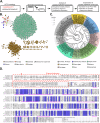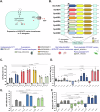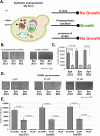Photosynthetic directed endosymbiosis to investigate the role of bioenergetics in chloroplast function and evolution
- PMID: 39658562
- PMCID: PMC11632070
- DOI: 10.1038/s41467-024-54051-1
Photosynthetic directed endosymbiosis to investigate the role of bioenergetics in chloroplast function and evolution
Abstract
Cyanobacterial photosynthesis (to produce ATP and NADPH) might have played a pivotal role in the endosymbiotic evolution to chloroplast. However, rather than meeting the ATP requirements of the host cell, the modern-day land plant chloroplasts are suggested to utilize photosynthesized ATP predominantly for carbon assimilation. This is further highlighted by the fact that the plastidic ADP/ATP carrier translocases from land plants preferentially import ATP. Here, we investigate the preferences of plastidic ADP/ATP carrier translocases from key lineages of photosynthetic eukaryotes including red algae, glaucophytes, and land plants. Particularly, we observe that the cyanobacterial endosymbionts expressing plastidic ADP/ATP carrier translocases from red algae and glaucophyte are able to export ATP and support ATP dependent endosymbiosis, whereas those expressing ADP/ATP carrier translocases from land plants preferentially import ATP and are unable to support ATP dependent endosymbiosis. These data are consistent with a scenario where the ancestral plastids may have exported ATP to support the bioenergetic functions of the host cell.
© 2024. The Author(s).
Conflict of interest statement
Competing interests: Authors declare that they have no competing interests.
Figures






References
-
- Mereschkowsky, C. Uber natur und ursprung der chromatophoren im pflanzenreiche. Biologisches Centralblatt25, 293–604 (1905).
-
- Margulis, L. Origin of Eukaryotic Cells: Evidence and Research Implications for a Theory of the Origin and Evolution of Microbial, Plant and Animal Cells on the Precambrian Earth. (Yale University Press, 1970).
-
- Zimorski, V., Ku, C., Martin, W. F. & Gould, S. B. Endosymbiotic theory for organelle origins. Curr. Opin. Microbiol.22, 38–48 (2014). - PubMed
-
- Martin, W. & Kowallik, K. V. Annotated english translation of Mereschkowsky’s 1905 paper ‘über natur und ursprung der chromatophoren im pflanzenreiche’. Eur. J. Phycol.34, 287–295 (1999).
Publication types
MeSH terms
Substances
Grants and funding
LinkOut - more resources
Full Text Sources

